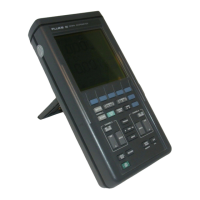3-8
CIRCUIT DESCRIPTIONS
Analog ASIC bus
The Analog ASIC(A-ASIC D2301, see circuit diagram A2aJA2b, figure 10.5/10.6) orA-ASIC, as used
In the following text, is controlled by tine rncroprocessor. The mtcrc^rocessor uses the signals CDAT,
CCLK and DTAEa,b,c to set the A-ASIC and the attenuator sections on the analog A2 PCB. These
signals toge^er form Ihe CONTROL bus.
Flash ROM type selection
The ScopeMeter hardware allows the usage of different types of Rash RO^/s. The actual Flash ROM
configuration Is indicated by resistors R1222 and R1224.
FLASH ROM CONFIGURATION
F51211X)
The resulting voltage levels
(0
volt, 2.5 vott or
5
volt) are read directly
by
the microprocessor A/D
converter inputs.
ON/OFF circuit
The ON^OFF circuit operates almost like a thyristor. When the ON/OFF key Is pressed,
a
current 1$
drawn from the
base
of
VI
503,
via R1 503 and
VI 501
.
Transistor VI
503 will now start to conduct. This
results in
a
current through R1507, R1504,
V1502
and R1506. The
signal
POWER.ON will
now
become "high*.
Also transistor
V1 506 will conduct, supplying base current to VI 503 after the ON/OFF
key Is released. The POWER-ON signal will latch "high*. The ON/OFF signal will
go
high, turning off
VI 506 and VI
503,
the next time the ON/OFF hey Is depressed. The POWER_ON signal will become
"low" and the ScopeMeter power turns 0IF.
RESBTelreuH
The RESET circuit consists of VI 203,
VI
205,
VI 21
5,
VI
201,
D1205 and related
components. When the ScopeMeter
power Is switched on, the -fSV supply
voltage starts to rise. This causes the
zener diode VI 202 to conduct. After some
time transistor V1 203 also starts to
conduct.
R1204 and Cl203form atime delay (see
figure
33).
switch
The RESET signal now Is buffered by
^ momem
D1 206 and connected with the RESET
Inputs of the microprocessor and the
Figure 3.3 RESET signal timing
D-ASIC circuitry.
After a reset, the voltage on the EA (External Address) input of the microprocessor (pin
14)
is 'high ".
The
Microprocessor
starts up using the
internal
Mask ROM software. Rrsithe Flash ROMs are
checked
to see
If they contain valid software, if this Is
true, ou^ut
pin
6 of
^ip'flop
D1202 is set "low
*.
Now the microprocessor invokes
a
software reset. Because
of
the "low** voltage
on the EA input
of
the microprocessor, the microprocessor will "start up" again, using the external Flash ROM software.
The
reset pulse is blocked
by
translstcw
VI
201
to
prevent
the RESET signal from performing a "hard-
reset" on the
microprocessor
agair>, At this software reset, the microprocessor enables the LCD by
means of the signal LCDPWR. Then the buffers that control the LCD contain valid data.
Resistor(s)
R1222
R1224

